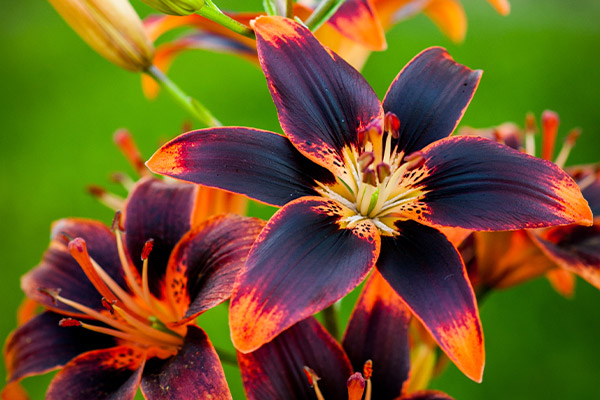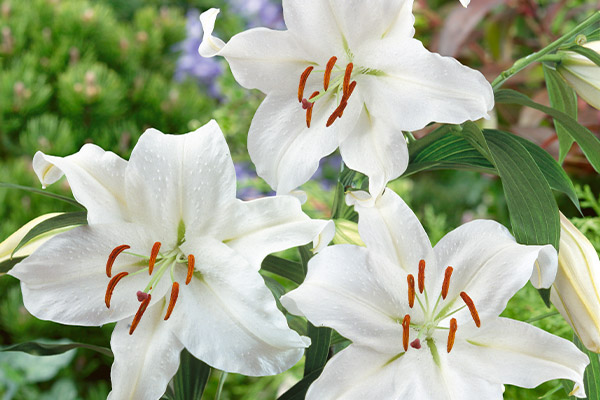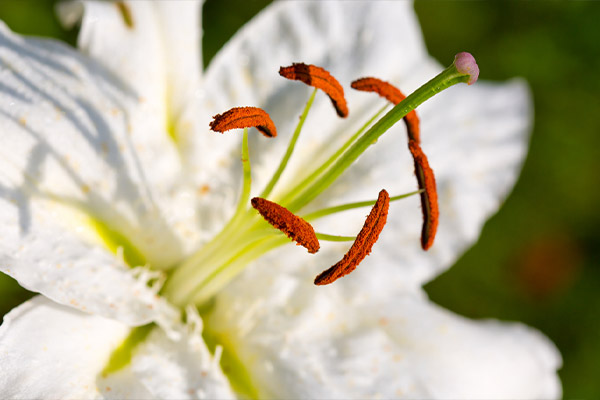
How Supplied
Our bulbs will be delivered fresh and healthy. There should be firm, not soft. Some bulbs may arrive with slight mould patches, but this is completely normal and can be brushed off. If you suspect that your bulbs are faulty, do not hesitate to get in touch.
Once your bulbs arrive, take them out of their packaging (including bags) and lay them out on newspaper so they can breathe. This is so they don’t excessively sweat in their containers, ruining the bulbs. Leave somewhere cool and dry until it’s time to plant them.
What We've Included
When to Plant | Where to Plant | How to Plant | When will they flower | After Care |
Common Issues | Inspiration | Further Reading
When to Plant
For the best results, plant your Lily bulbs from October to early April. If you receive your bulbs before the planting season, then store them in a cool and dry place until it’s time to plant them out.
Our bulbs will be delivered fresh and healthy. They should be firm, not soft. Some of our dry bulbs may arrive with slight mould patches, but this is completely normal and can be brushed off. If you suspect that your bulbs are faulty, do not hesitate to get in touch.
Where to Plant
Lilies will benefit the most when planted somewhere deep. This includes beds or large pots and containers. They prefer a sunny but sheltered spot, where they will happily grow throughout the season.
Grow your bulbs in areas that reach plenty of sunlight but aren’t exposed to harsh weather conditions. This could risk them getting blown over, ruining their chances of survival.
If you worry about a lack of sunlight exposure in your garden, flowerpots can be incredibly helpful. Simply move them to wherever the sun is positioned!

How to Plant
Although these bulbs are easy to plant, there are a few things to note to help them flower correctly. For example, many may need supports as they grow to keep them tall and strong.
There are two main types of Lily – Asiatic and Oriental. These two varieties need slightly different soil conditions. Asiatic lilies prefer alkaline soil, so you can plant them in peat-free compost. Oriental lilies prefer acidic soils, so plant in soil that has ericaceous compost (either added to containers or mixed in with the soil in beds).
Borders
1. Dig a hole that’s wide enough to fit the bulb comfortably, and at least 3 times the bulb’s depth.
2. Pop each bulb into their holes, pointed side up. Space your bulbs around 15cm apart.
3. Cover with soil and pat down gently. Do not step on the area, as it can damage the bulbs.
Containers
For the best results in containers, try and leave at least 12cm of potting soil between the bulb and the top of the pot. This will help to anchor them into place and will also give them extra protection over winter.
1. Fill the pot with the correct compost, until you’ve reached its halfway point.
2. As a rule of thumb, bulbs should be planted as deep as you would plant them in borders, as they can be quite tall and need a good anchor.
3. Place your bulbs on top of the soil and cover with the compost to the top of the pot. Break up any lumps as you go.
4. Gently press the soil so that it’s nice and flat.
5. Make sure you place your pot on feet to allow the moisture from the pot to escape.
Watch Our Videos On How to Plant Dahlias
Watch: How to Plant Dwarf Lilies
Watch: How to Plant Short Stemmed Lilies
Watch: How to Plant Goliath Lilies
When will they Flower?
There are two main types of Lily – Asiatic and Oriental.

Asiatic Lilies
Asiatic lilies tend to appear in June and start to fade toward late summer. They’re incredibly hardy and produce an abundance of blooms through their season! Perfect for creating an impressive summer display. Notable varieties of Asiatic lilies include the gorgeous Lily Foxtrot that is a dwarf-flowering bloom and the striking Bright Diamond that produces pure white blooms from June.

Oriental Lilies
Oriental Lilies usually appear once Asiatic lilies start to fade, around the August mark. Oriental lilies produce bright and colourful flowers, often bicoloured, which can help you create a striking summer display. Popular varieties include the Lily Purple Lady that reaches impressive heights of 2.5m and the lovely Lily Mona Lisa that produces white and pink spotted leaves.
After Care
When to water
Lilies of both varieties do not sit well in waterlogged soil and will rot if left in overly wet conditions. Water around once a week, or if the soil is dry beneath the surface. Water potted lilies until you see the water run from the bottom of the container and do not water again until the soil is dry beneath the surface.
What to do once they’ve finished blooming
Bulbs get all their energy from the sun once they’ve stopped flowering, so never cut the plant all the way down to surface level before it has naturally died back. Once the flowers have died, feel free to trim the top third of the plant and leave the foliage to die back on its own. They will usually be a brown or golden colour once died.
Propagation
Like many bulbs, Lilies will naturalise when left to their own devices. This is wonderful because each year your display will look fuller! However, every three years or so, you may find that the new bulbs are suffocating the old ones. This is when you should lift the bulbs and divide them to replant elsewhere.
Directions:
1. Gently uncover the bulbs using a small spade or fork. Be careful not to pierce or damage the bulbs while doing this.
2. Brush off any remnants of soil and dirt gently. If the bulb feels a bit squishy, it could be a sign of damage or disease and is best thrown away.
3. Replant the new bulbs directly into their new area or pot up in individual small pots until ready to plant in mid to late autumn.
Deadheading
Deadheading can help redirect the bulb’s energy into creating a new flower once the other one has wilted. It also helps to keep the flower bed looking tidy and uniform whilst the others are still in bloom. Simply cut the spent flower with clean shears, just above the leaves.
Common Issues and How to Solve Them
Lily Beetles
One of the most common issues that you might find with lilies is the red lily beetle. These brightly coloured pests are often spotted from March to October, as they eat the foliage. The best way to mitigate this issue is to be on the lookout for larvae and eggs on the stems and underside of leaves and remove them as soon as you spot them.
Keep Away from Cats
Unfortunately, lily bulbs are incredibly toxic and fatal to cats, so it’s best to not buy them if you do have a furry friend to think about.

Ready to Shop?
Find some inspiration for your garden
Want to Know even more about Lilies?
Take a look at our helpful blogs


